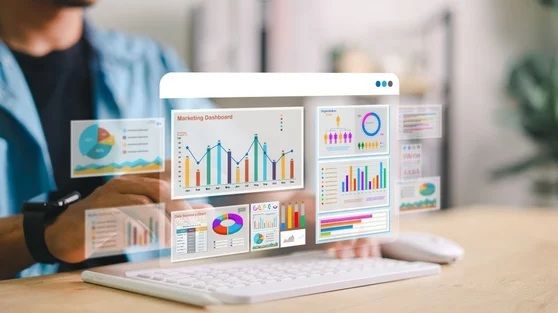Know Your Rivals: Master Competitive Analysis for Business

Summary: Understand the value of a competitive analysis and how it can help you identify opportunities, outsmart your rivals, and strengthen your market position.
With the revolution of AI and digital marketing, understanding your competition has become more critical than ever. It is essential to know who you are competing with, what they offer, and how their businesses work. This knowledge can give you valuable insights to stay ahead of the game.
A detailed competitive analysis for your business helps reveal market trends, find gaps, and create strategies that take advantage of your unique selling proposition and product/service offering. In this article, we’ll show you how understanding your competitors with the help of a competitive analysis can fuel smarter strategies and drive growth for your business.
What is a Competitive Analysis?
A competitive analysis is a strategy that helps companies assess their competitors’ products, services, sales methods, and market placements. This detailed assessment reveals your competitors’ strengths and weaknesses, giving you a precise understanding of how your business is doing comparatively. It also highlights areas where your company can grow.
An annual competitor analysis is a good rule of thumb for businesses. This helps you get to know your business environment, improve what you offer, and stay ahead in your industry. Many companies hold beliefs about their rivals that may need to be updated or corrected. A competitor analysis can fix these misunderstandings, giving you the power to make decisions based on facts to improve your marketing strategies and business activities.
Why is a Competitive Analysis Important?
A competitive analysis is important because it helps businesses understand their position in the market, identify key competitors, and uncover opportunities to differentiate and grow. By analyzing competitors’ strengths, weaknesses, strategies, and customer engagement, businesses can make more informed decisions, improve their SEO, refine marketing tactics, and optimize product offerings. It also reveals gaps in the market, tracks industry trends, and guides long-term strategic planning. With the support of AI tools, competitive analysis becomes faster and more accurate, enabling smarter, data-driven actions that give businesses a true competitive edge.
Why Do a Competitor Analysis?
.png?width=561&height=932&name=unnamed%20(54).png)
1. Understand Your Market Landscape
Competitor analysis reveals who you’re up against and how they position themselves online. It helps you:
- Identify market leaders and emerging players
- Understand industry trends and customer expectations
- Benchmark your performance against top competitors
2. Uncover Strengths & Weaknesses
By analyzing your competitors’ strategies, you can:
- Spot gaps in their content, SEO, or customer service
- See what they’re doing well—and where they’re falling short
- Use this intel to differentiate your brand
3. Improve Your SEO Strategy
We often look at:
- What keywords your competitors rank for (and you don’t)
- Their backlink profile and domain authority
- How their site structure and content strategy are built
This allows us to refine your SEO approach to target untapped or high-value search terms.
4. Identify Content & Messaging Opportunities
By evaluating your competitors’ blogs, social media, and ad messaging, we can:
- Identify the tone and topics that resonate with your shared audience
- Find content gaps or trending topics you can own
- Refine your unique value proposition
5. Optimize Paid Search Campaigns
Competitor analysis tools (like SEMrush or SpyFu) show:
- What ads are your competitors running
- Which landing pages are they sending traffic to
- What offers and CTAs are they using
This helps optimize your Google Ads strategy to compete more effectively—and more efficiently.
6. Guide Product or Service Improvements
Understanding competitors’ product features, pricing, and customer reviews helps you:
- Benchmark your offerings
- Innovate or improve your services
- Better align with customer expectations
7. Support Long-Term Strategic Planning
Competitor insights are essential for:
- Identifying emerging trends and threats
- Spotting market saturation or new niches
- Guiding investments in tech, content, or expansion
What is Competitive Market Research?
Competitive Market Research is the process of systematically analyzing your competitors and the broader market landscape to gain insights that inform your business and marketing strategies. In simple terms, competitive market research helps answer:
“Who else is targeting our audience, what are they doing, and how can we do it better?”
Key Components of Competitive Market Research
1. Competitor Identification
- Who are your direct and indirect competitors?
- Are there new players entering your space?
2. Product/Service Analysis
- What are competitors offering?
- How do their products or services compare to yours (features, pricing, quality)?
3. Marketing Strategy Breakdown
We look at:
- SEO rankings and keyword strategy
- Content marketing (blogs, videos, case studies)
- Paid advertising (Google Ads, social, retargeting)
- Social media presence and engagement
- Email marketing and lead generation tactics
4. Audience Targeting
- Who are they targeting?
- How do they communicate with that audience?
- What platforms are they using?
5. Brand Positioning
- What’s their unique value proposition (UVP)?
- How are they differentiating themselves?
6. Customer Sentiment
- What are customers saying in reviews or on social media?
- Are there consistent complaints or praise?
- What are the loyalty signals?
7. Technology Stack
- What tools or platforms are they using (e.g., chatbots, CRMs, eCommerce platforms)?
- Are they using AI or automation?
What is Included in a Competitive Analysis?
An effective competitive analysis report may include:
1. Competitor Identification
- Direct competitors (same products/services, same audience)
- Indirect competitors (alternative solutions to the same problem)
- Emerging competitors or disruptors
We also assess local vs. global competitors if your market spans multiple regions.
2. Website & UX Evaluation
- Site speed, structure, and user experience
- Mobile-friendliness and responsiveness
- Conversion pathways (CTAs, forms, chat features)
- Accessibility and compliance (especially important for legal and inclusive access)
3. SEO Performance
- Keyword rankings (where they rank vs. where you rank)
- Domain authority and backlink profiles
- Content structure and topic clusters
- On-page optimization (titles, meta tags, headings)
We look for gaps and opportunities to boost your visibility in search engines.
4. Content & Messaging Strategy
- Tone, voice, and brand consistency
- Types of content used (blogs, videos, whitepapers, etc.)
- Publishing frequency and engagement
- Alignment with buyer personas
This helps shape a stronger content marketing plan tailored to your audience.
5. Paid Advertising Insights
- Google Ads and social media ad activity
- Keyword targeting and ad copy
- Estimated ad spend and ROI (when available)
- Landing page performance and offer strategy
Useful for optimizing your PPC campaigns and budget allocation.
6. Social Media Presence
- Platforms used (Facebook, LinkedIn, Instagram, etc.)
- Posting frequency and engagement levels
- Follower growth and community sentiment
- Influencer partnerships or brand collaborations
This informs your social media strategy and how to differentiate.
7. Customer Sentiment & Reviews
- Online reviews (Google, Yelp, G2, Trustpilot, etc.)
- Social mentions and reputation trends
- Strengths and pain points revealed in feedback
This helps you improve customer experience and enhance your brand reputation.
8. Tech Stack & Innovation
- CRM, eCommerce, and automation platforms are used
- Use of AI (chatbots, personalization, predictive analytics)
- Any tools that give them a competitive edge
This guides your digital transformation roadmap.
9. SWOT Analysis
Summarize findings into a clear framework:
- Strengths: What your competitors are doing well
- Weaknesses: Where they fall short
- Opportunities: Gaps you can exploit
- Threats: Risks to be aware of
10. Strategic Recommendations
Based on everything we find, we provide:
- Actionable insights to improve your marketing strategy
- Prioritized opportunities for growth
- Data-backed suggestions to differentiate and win
Identifying Your Top Competitors
Before conducting a competitive analysis, you need to identify your competitors. While you may already have a good idea of who they are, keep in mind that markets evolve—and so do your competitors. There are two primary classifications of rivals: direct and indirect. Understanding the distinction between these types helps you grasp their influence on your business and find ways to maintain a competitive advantage.
Direct vs Indirect Competitors
.png?width=574&height=756&name=unnamed%20(55).png)
What are Direct Competitors?
Businesses that provide the same or comparable products and services as your company are known as direct competitors. They aim for the same customer group and compete in an identical market. For example, if you have a coffee shop, other nearby coffee shops would be considered your direct competitors because they sell a similar primary product—coffee—to similar customers. Examples of direct competitors include:
- McDonald’s and Burger King
- Nike and Adidas
- Zoom and Microsoft Teams
- Uber and Lyft
- Amazon and Walmart
Rivalry is equally intense in the online world. To illustrate, Netflix and Hulu are immediate rivals as they both provide content streaming services to similar viewership groups.
How to Identify Your Direct Competitors
To effectively identify your direct competitors, you must undertake a comprehensive approach involving several vital steps. Here’s how to identify your direct competitors:
- Market Research: Start by evaluating the market for your service or product. Then, recognize businesses that provide similar products and review their marketing strategies. Finally, collaborate with your sales team to learn which rivals they commonly encounter.
- Client Opinion: Ask your clients/customers to share how they made their choice. Ask about any other brands or products they considered before opting for yours. This opinion helps you discover direct rivals that may have gone unnoticed.
- Web Communities and Social Media: Monitor discussions on Reddit, Quora, and other social media outlets. Customers frequently share their likes, dislikes, and experiences on these sites, which can provide valuable insights into your competitors.
What are Indirect Competitors?
Indirect competitors provide different products or services but fulfill similar customer requirements. Even if their offer differs, customers may choose their product over yours. To illustrate this point more clearly, consider that a local coffee shop may see competition from a fast food chain that sells breakfast beverages. While the products differ, they fulfill the same consumer desire for a morning drink. Examples of indirect competitors include:
- Netflix and cable TV providers
- Online learning platforms (like Udemy) and traditional universities
- Ride-sharing services (like Uber) and public transportation
- Meal kit delivery services and grocery stores
Understanding both types of competition is crucial for your digital marketing and business strategy. Direct competitors focus on features, pricing, and quality, while indirect ones might entice customers through convenience, availability, or how the brand is perceived.
How to Identify Indirect Competitors
Similarly, you must undertake a comprehensive approach to identify your indirect competitors effectively. Here’s how you can identify your indirect competitors:
- Keyword Research: Use keyword tools to pinpoint businesses trying to rank for your desired keywords. While they may offer different products, you will often see indirect rivals in search outcomes related to important topics that overlap with your business.
- Study Google Search Results: It is crucial to your value proposition to check who ranks for your target keywords. If other businesses write content that clashes with yours, they might be indirect competitors.
- Look at Paid Advertising Information: Use platforms such as Google Ads to check which enterprises are betting on keywords associated with your services or products. In general, high rivalry in paid ads usually signifies potent indirect competitors.
Key Metrics that Reveal Your Competitors’ Performance
An effective competitive analysis focuses on the right metrics to uncover valuable insights about your rivals. Here are a few key metrics that reveal how your competitors are performing in the market:
- Website Traffic: Understanding competitors’ website traffic provides a sense of their market visibility and audience reach.
- Engagement Metrics: Factors like bounce rates, average session duration, and pages per session reveal how well competitors’ content keeps users engaged.
- Social Media Performance: Growth in followers, likes, shares, and comments highlights which social strategies are driving engagement and capturing audience attention.
- Conversion Rates: Measuring how effectively competitors turn website visitors into leads or sales offers insight into their marketing and sales strategies.
- Pricing Strategy: Observing competitors’ pricing and how adjustments impact their market share can uncover opportunities to strengthen your own competitive positioning.
Tools That Support a Competitive Analysis (But Why Expertise Matters)
There are several tools available to support the creation of a competitive analysis, but using them effectively requires more than just access—it demands specialized knowledge and experience. These tools generate data, but the true value lies in interpreting that data to uncover actionable insights and applying those insights strategically to drive results.
Here are a few tools often used to gather competitive intelligence:
- Similarweb: Provides website traffic insights and helps benchmark performance.
- Sprout Social: Provides comparative analytics for social media and assists in evaluating your competitors’ social media performance.
- Ahrefs/Semrush: Comprehensive SEO tools for keyword analysis, position tracking, and market insights.
Think of a competitive analysis like diagnosing a car problem. Tools like diagnostic scanners can show you error codes or warning lights, but that doesn’t mean you know what’s wrong with the engine, or how to fix it. A professional mechanic uses the tools and their expertise to identify the issue and get you back on the road faster.
Similarly, at WSI, we don’t just rely on tools. We combine these resources with our deep digital marketing expertise to deliver a competitive analysis that reveals opportunities, drives smarter strategies, and helps your business stay ahead of the competition. Tools provide the data, but it’s human insight and strategic thinking that turn that data into measurable results.
Applying and Monitoring Results
Once you have a competitive analysis for your business, you can implement this knowledge and observe the outcomes. With these insights, improve your product’s attributes, marketing methods, and price points. Using structures such as SWOT (Strengths, Weaknesses, Opportunities, Threats) or Porter’s Five Forces analysis could be beneficial for making strategic choices.
You should always keep your analysis updated to be mindful of changes in the market and competitors’ strategies. This forward-thinking method assists you in foreseeing industry trends, taking advantage of possibilities, and dealing with possible dangers before they affect your business.
Benchmarking Against Competitors
Benchmarking is essential in a competitor analysis because it allows you to compare your business performance with others within your industry. It provides knowledge about your market position and identifies areas requiring enhancement. To effectively benchmark against competitors, focus on key performance indicators (KPIs) such as:
- Income and Market Portion: Compare your sales numbers to your competitors’ market shares.
- Customer Satisfaction: Measurement tools like Net Promoter Score (NPS) can help you understand customer devotion and happiness.
- Website Traffic and Digital Presence: Evaluate your visibility on the internet, where your traffic is coming from, and how much engagement you’re getting compared to your competitors.
- Pricing Strategy: Check how your product’s price relates to the prices of competitors’ products. This will help you understand your value proposition and ability to dictate pricing.
- Engagement on Social Media: Monitor social media activity, followers’ growth, and levels of interaction to judge your brand’s influence.
Developing Strategies Based on Your Competitive Analysis Results
The knowledge obtained from your competitive study and SWOT results should be applied to develop practical strategies. Here’s how to change your analysis into a strategic plan:
- Use Your Strengths: Use your strengths to differentiate your business and highlight what sets you apart from the competition. For instance, if excellent customer service is a strength, promote this.
- Address Weaknesses: Make plans to improve your weak spots. If you don’t have a solid online presence, consider investing in improving your online marketing strategy.
- Take Advantage of Opportunities: Pay attention to opportunities that provide the greatest potential for expansion. For instance, if there’s a movement toward environmentally friendly products, consider starting an eco-responsible product series.
- Reduce Risks: Make backup plans to lessen the effects of any dangers you discover during your analysis. If new rules or regulations present a hazard, ensure your company remains in line and adaptable.
How Can AI Improve the Speed and Accuracy of a Competitive Analysis Report?
.png?width=764&height=573&name=unnamed%20(56).png)
AI significantly enhances both the speed and accuracy of a competitive analysis report by automating data collection, identifying patterns, and reducing human error.
- Automated Data Collection
AI tools can scan thousands of web pages, social profiles, product listings, and ad campaigns in seconds, much faster than manual research. This means your team can make informed decisions without spending weeks gathering data. - Real-Time Monitoring
AI can continuously track competitor updates—like changes in pricing, new content, or shifts in marketing tactics—and flag them immediately. This helps you stay agile and respond faster. - Data Aggregation Across Channels
AI pulls data from multiple marketing channels (e.g., websites, Google Ads, social media) and presents it in a unified view. This reduces inconsistencies and provides a more complete picture of your similar market. - Keyword & SEO Intelligence
Using natural language processing (NLP), AI tools analyze large volumes of SEO data, helping identify competitor keywords, content gaps, and areas where you can improve your position in the market. - Accuracy Through Pattern Recognition
AI identifies trends, correlations, and anomalies that humans might miss, such as hidden seasonal patterns in ad spend or subtle shifts in audience sentiment. - Customizable Templates
Some AI tools can generate a competitive analysis report template customized to your industry and target audience, cutting down on setup time while improving accuracy.
What Role Does Machine Learning Play in Predicting Competitor Behavior?
Machine learning (ML) is the branch of AI that helps systems “learn” from historical data and predict future actions, making it an incredibly useful asset in competitive analysis.
- Trend Analysis & Forecasting
ML models can identify long-term patterns in a competitor’s behavior, like when they launch seasonal campaigns or how they adjust pricing, and use that data to forecast what they’ll likely do next. - Customer Behavior Insights
By analyzing customer feedback from reviews or social sentiment, ML can reveal shifts in public perception of competitors, helping you prepare counter-messaging or new offers in response. - Content & SEO Strategy Prediction
ML can evaluate the evolution of a competitor’s content strategy (topics, formats, frequency) and predict what areas they might target next, allowing you to fill gaps in the market preemptively. - Ad Spend & Campaign Modeling
By processing historical ad data, ML algorithms can estimate when and where your competitors will increase marketing efforts, helping you time your own campaigns more effectively. - Early Warning Signals
ML models detect small but significant changes in digital signals, like reduced posting frequency or domain rank drops, that may indicate financial stress, rebranding, or expansion plans.
The Complex Nature of Competitive Analysis
On the surface, conducting a competitive analysis might seem straightforward—gather data on your competitors and adjust your strategy—but the reality is far more nuanced. Here’s why:
- Keeping Up with Real-Time Changes: Competitors’ strategies, offerings, and market positions are always evolving. Staying current requires ongoing monitoring and the ability to adapt quickly.
- Direct vs. Indirect Competitors: It’s not just your direct rivals you need to watch. New players, adjacent markets, or disruptors can emerge unexpectedly and change the competitive landscape.
- Interpreting Data for Actionable Insights: Tools and platforms generate data, but making sense of it—finding patterns, identifying opportunities, and turning it into strategic action—requires expertise.
This complexity highlights a critical point: competitive analysis isn’t just about gathering information—it’s about knowing what to do with it.
Create Your Competitive Analysis Report and Help Your Business Today
At WSI, we specialize in transforming complex market data into actionable insights. With a custom-built competitor market analysis, you’ll see where your brand stands, who you’re competing with, and how to reach your target market strategically across the right marketing channels. Don’t rely on guesswork. Let us help you identify gaps in the market, analyze your competitors’ marketing tactics, and build a smarter, more focused strategy to improve your business.
Want to uncover your competitive edge? Let WSI turn complexity into clarity. Sign up for expert advice today and discover how a professionally crafted competitive analysis for your business can keep you one step ahead.
About the Author
Rick spent 20 years in the insurance industry in finance, primarily developing reporting platforms for B & C stakeholders. His ability to speak to consumers of data (managers and analysts) and translate their needs to programmers led him to start his own digital marketing agency in 2004 to develop data driven solutions for business owners.
The Best Digital Marketing Insight and Advice
We are committed to protecting your privacy. For more info, please review our Privacy and Cookie Policies. You may unsubscribe at any time.
Don’t stop the learning now!


